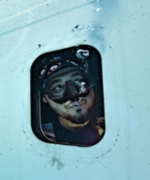
Entering the European dive tourism market
Diving is a risky activity, and specialist diving business insurance and high safety standards are essential requirements. Being sustainable as a diving business is also crucial to minimising negative impact on the delicate underwater ecosystem. European tour operators that specialise in diving holidays and local dive operators are the main sales channels for European divers. Top developing diving destinations are Egypt, Mexico, Indonesia, and the Galápagos Islands in Ecuador.
Contents of this page
- What requirements and certifications must dive tourism meet to be allowed on the European market?
- Through which channels can you get diving travel products on the European market?
- What competition do you face on the European dive tourism market?
- What are the prices of diving travel products on the European market?
1. What requirements and certifications must dive tourism meet to be allowed on the European market?
The European tour operator market must comply by law with several regulations to ensure their travelling clients are safe and are protected financially. To do business with the European market you must align your business processes with theirs so you can meet their expectations. European tour operators will expect you to meet conditions they set in a Code of Conduct and/or Terms of Business. Sustainability in all areas of tourism provision is essential for all European tourism suppliers. You must include sustainable actions throughout all your business activities.
What are the mandatory and additional requirements that buyers have?
The mandatory and additional requirements for dive tourism services are common across the sector. They include:
- The European Package Travel Directive
- General Data Protection Regulation (GDPR)
- Liability Insurance and Insolvency Protection
You can find out about them in CBI’s What are the requirements for tourism services in the European market?. The study will help you understand the legal, non-legal and common requirements European tour operators must comply with. If you understand the requirements they are bound by and can adapt your business to meet their needs, they are more likely to do business with you. It is important to European buyers that they can trust their suppliers to meet their and their customers’ needs.
What are the requirements for niche markets?
Diving is one of the riskier activities to undertake while on a trip abroad, and there are many requirements for a diving business to consider. As well as excellent diving conditions, there are several tangible requirements to operate, and specialist diving insurance is a must. Being a sustainable tour operator is also essential to help meet the urgent need to stop diving-related damage to coral. Implementing internationally recognised ISO standards is likewise recommended.
Understand what is required to set up a diving business
To set up a diving business, you must be in a place where there are good diving conditions. These include but are not limited to:
- A variety and quantity of dive sites that include reefs, wrecks, artificial reefs and an abundance of marine life
- The presence of a unique natural occurrence, such as a sardine run or seasonal gathering of marine life for feeding, breeding or birthing
- Excellent clarity of water for optimal diving
- Year-round diving opportunities
There are different types of dive businesses, including dive centres and shops, dive resorts, dive schools and training centres, and diving tour operators. To function as a diving tour operator you will need to consider the following tangible (physical) requirements:
- Dive shops from which to rent equipment, including wetsuits, BCDs, masks and snorkels, fins, tanks and weights
- Facilities to supply and refill tanks
- Access to suitable fleets of dive boats for day trips and/or liveaboard
- Access to a decompression chamber and other safety features
- Properly trained staff
- Dive resorts/hotels and liveaboard accommodation options to suit a range of budgets
- Activities for non-diving companions
It is a good idea to partner with one of the main dive training associations, but it is not mandatory. However, if you want to offer dive courses and dive certification, you will need to affiliate with a recognised dive training association. The main organisations are:
- Professional Association of Diving Instructors (PADI): US-based PADI is the world’s largest dive organisation for recreational scuba diving training and certification.
- Scuba Schools International (SSI): an international organisation and one of the largest with a presence in over 110 countries.
- Confederation Mondiale des Activities Subaquatiques (CMAS): an international federation that offers an international system of recreational snorkel and scuba diving training.
- National Association of Underwater Instructors (NAUI): US-based NAUI is a globally recognised non-profit organisation dedicated to promoting safe and responsible scuba diving.
Opening a dive business is a time-consuming process that can take anywhere from 6 to 12 months. PADI publishes a useful guide to starting a dive business or planning to purchase an existing dive business.
Tips:
- Remember that divers often travel with non-diving companions. Think about what you can offer them. A free snorkel loan is one idea, as are trips to other beaches where they can relax while their companion enjoys a dive.
Get specialist diving business insurance
Diving is a risky activity and diving businesses need insurance to protect against a variety of risks and liabilities. These include accidents and injuries, mistakes or negligence, equipment damage or loss, and damage to buildings or boats. Some insurance policies will also cover your clients in the case of trip cancellations, medical emergencies and other unforeseen events.
- The Divers Alert Network (DAN): a group of non-profit organisations dedicated to improving diving safety for all divers through research, education and emergency medical assistance. It provides insurance for both divers and dive businesses that covers general liability, professional liability for instructors, and equipment.
- PADI (Professional Association of Diving Instructors): offers insurance plans through PADI-endorsed insurance providers. Policies are designed for dive centres, resorts and instructors.
- Vicencia & Buckley Insurance Services: specialises in providing insurance for the dive industry. They offer a range of policies for dive shops, resorts, instructors and charter operators.
- DiveAssure: provides comprehensive insurance for dive professionals and businesses, including liability insurance and travel insurance that covers dive-related incidents.
Tips:
- Investigate the best insurance option for your business. Contact each of the businesses listed to assess what they offer.
- Make it mandatory for divers to have their own personal insurance when they dive with you. Although it will not absolve you of responsibility, they are more likely to claim on their own insurance if there is an accident.
- Undertake a risk analysis for your business. You must have a plan in place to refer to when a crisis occurs. You can use the CBI guide How to manage risks in tourism?
Incorporate sustainability into a dive business
You must incorporate sustainability into your dive business to protect marine environments and ensure long-term health. It is widely known that coral reefs are suffering from the effects of climate change and diver-related damage, as this infographic shows.
Figure 1: Diver-related damage
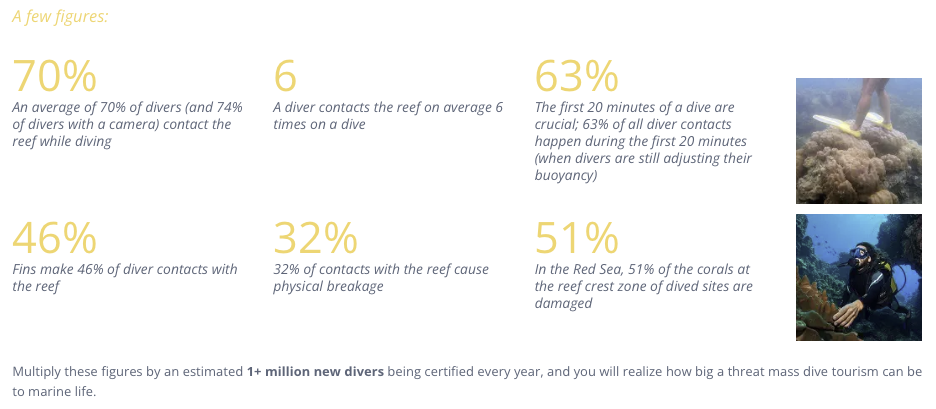
Source: SeaHorse Diving Club, 2024
Consider becoming a certified Green Fins member. Green Fins is a non-profit membership organisation that works to protect and conserve coral reefs. The organisation provides practical, low-cost alternatives to harmful practices (like anchoring, feeding fish and chemical pollution), and offers strategic training, support and resources.
There are two types of certification: certified and digital membership. Certified members are in ‘active’ Green Fins countries, currently Antigua and Barbuda, Costa Rica, Dominican Republic, Egypt, Indonesia, Japan, Jordan, Malaysia, Thailand and the Philippines. Businesses are assessed in person and undergo annual training.
Digital membership is mostly for dive businesses in countries that are not yet Green Fins active countries. They make the same commitment to implement the Green Fins code of conduct and self-manage their sustainability activities online. Some digital members are also working towards full certification in their own active countries.
Green Fins publishes a wide range of materials and guidelines that members (and others) can use to encourage their guests to use and follow. There are many helpful materials to download, including the one below.
Figure 2: Green Fins’ guidelines for divers
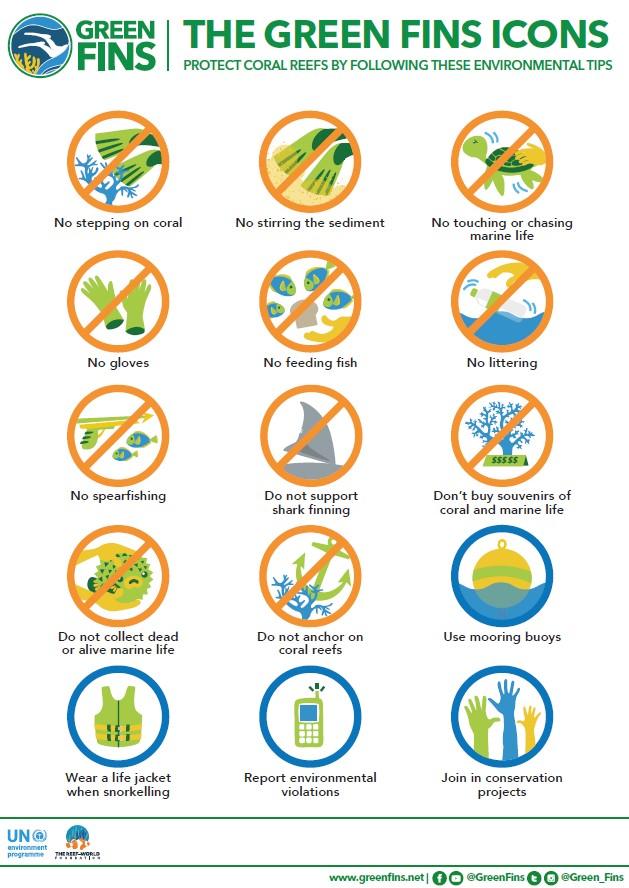
Source: Green Fins, 2024
For best-practice examples, consider the environmental efforts of these diving businesses, which are Green Fins members.
- Evolution Diving Resort, Philippines – a certified gold member and one of Green Fins’ global top-10 in terms of having the lowest environmental impacts. The operator has made it its ethos to clean up rubbish from the sea on every dive. Dive instructors take mesh bags with them, and divers can also take part if they feel confident enough.
- Arab Divers, Jordan – besides having Green Fins’ silver certification, Arab Divers is a 5-star PADI resort and also has a PADI Green Star Award.
- Wunderpus Liveaboard, Indonesia – has Green Fins’ silver certification, plus it is affiliated with other environmental organisations, like Dive Operators Collaboration (DOCK) and MantaWatch.
Tips:
- Contact Green Fins to find out what you must do to become a member. If you are not in an active country, lobby your national diving industry to see if you could promote your country to become a Green Fins active country.
- Encourage guests to behave responsibly using Green Fins materials to help you. For instance, put up Green Fins posters and/or ask them to use reef-friendly sun cream, and never to touch coral or marine life.
- Introduce some sustainable activities like a beach clean-up and encourage guests to take part.
- Promote your sustainability activities on your website. Many dive operators do not talk about their sustainability actions. You will be more appealing to sustainably-minded European divers if you can prove that you’re proactively promoting sustainability in diving.
Put in place standards for management and safety
Complying with internationally recognised standards aimed at effective management and good safety practices is recommended for diving. Although they are voluntary, standards can help small businesses be confident that their product is safe and of good quality. ISO (International Organisation for Standardization) publishes many standards that have been approved by experts.
Each standard is given a number (e.g. ISO 21416), followed by the year it was published (e.g. 2019), so you can see how recently it was created. The standards for scuba diving are listed in the table below.
Table 1: Standards for scuba diving
| Standards for scuba diving | Type and Cost | Details |
Requirements and guidance on environmentally sustainable practices in recreational diving | Requirements and guidance Cost: €63 | This standard specifies requirements for service providers about responsible practices for the provision of their services. It covers recreational diving-related activities, including but not limited to scuba diving, snorkelling and free driving. |
Requirements for recreational diving providers | Requirements Cost: €63 | This standard specifies requirements for providers of recreational scuba diving and snorkelling excursion in the following areas:
|
Requirements for introductory programmes to scuba diving | Requirements Cost: €63 | This standard specifies the minimum programme content requirements for training organisations for introductory scuba experiences in recreational scuba diving. |
Requirements for the training of recreational scuba divers – Part 1: Level 1 – Supervised diver | Requirements Cost: €63 | This standard specifies how competent a scuba diver must be to obtain diver qualification at level 1, according to the training organisation. |
Requirements for the training of recreational scuba divers – Part 2: Level 2 – Autonomous diver | Requirements Cost: €63 | This standard specifies how competent a scuba diver must be to obtain diver qualification at level 2, according to the training organisation. |
Requirements for the training of recreational scuba divers – Part 3: Level 3 – Dive leader | Requirements Cost: €63 | This standard specifies how competent a scuba diver must be to obtain diver qualification at level 3, according to the training organisation. |
Requirements for the training of scuba instructors – Part 1: Level 1 | Requirements Cost: €63 | This standard specifies how competent a scuba instructor must be to obtain instructor qualification at level 1, according to the training organisation. |
Requirements for the training of scuba instructors – Part 2: Level 2 | Requirements Cost: €63 | This standard specifies how competent a scuba instructor must be to obtain instructor qualification at level 2, according to the training organisation. |
Source: ISO, 2024
Safety is absolutely essential in diving. Divers and European dive tour operators will seek proof that you will keep your guests safe at all times. This extends to your whole business – equipment, boats, tanks, dive instructors and your overall professionalism. If you provide services to a European tour operator, they will usually conduct a physical inspection of diving equipment and facilities.
You should consult the IDSSC (International Diving Safety Standards Commission) website. It supports businesses to put in place the latest standards and procedures for safe diving. It also provides information about countries’ diving associations and published regulations so you can align yours with those as necessary.
Tips:
- Study the ISO standards as listed in the table above. If you cannot afford to become ISO-certified right now, use the standards as guidance and implement what you can.
- Find out the safety regulations outlined by European diving associations. Make sure your safety standards are aligned.
- Regularly inspect and perform maintenance on all your equipment. If you contract a boat operator or other third-party services, ensure they do the same. Make sure you train all your staff on safety and maintenance procedures.
2. Through which channels can you get diving travel products on the European market?
European divers use a mix of European tour operators and direct sales with local dive businesses to book their diving experiences. The market of European tour operators is very large and can be found in trade shows, dive associations, specialist diving publications, and internet searches.
How is the end market segmented?
European divers are segmented into three major groups: leisure divers, passionate or hardcore divers, and active recreational divers.
- Leisure divers: occasional divers who often learn to dive or try diving when on holiday. They account for the largest segment, around 70% of the diving community.
- Passionate/hardcore divers: experienced divers, often with more than one diving qualification, who actively choose destinations to travel to, specifically to dive.
- Active recreational divers: dive regularly but most often in their home countries. This group accounts for 10% of the diving market.
Tip:
- For more information about the segmentation of the diver market, read the CBI study What opportunities are there on the European dive tourism market?
Through which channels does a product reach the end market?
Sales channels for dive tourism include specialist diving tour operator companies and general tour operators that incorporate diving into their itineraries. Direct sales are also commonly used, from locally based dive schools and centres, dive businesses, dive resorts and other local providers. Leisure divers likewise use online travel agencies (OTAs) for one-off dive trips and to try diving.
Figure 3: Sales channels for dive tourism
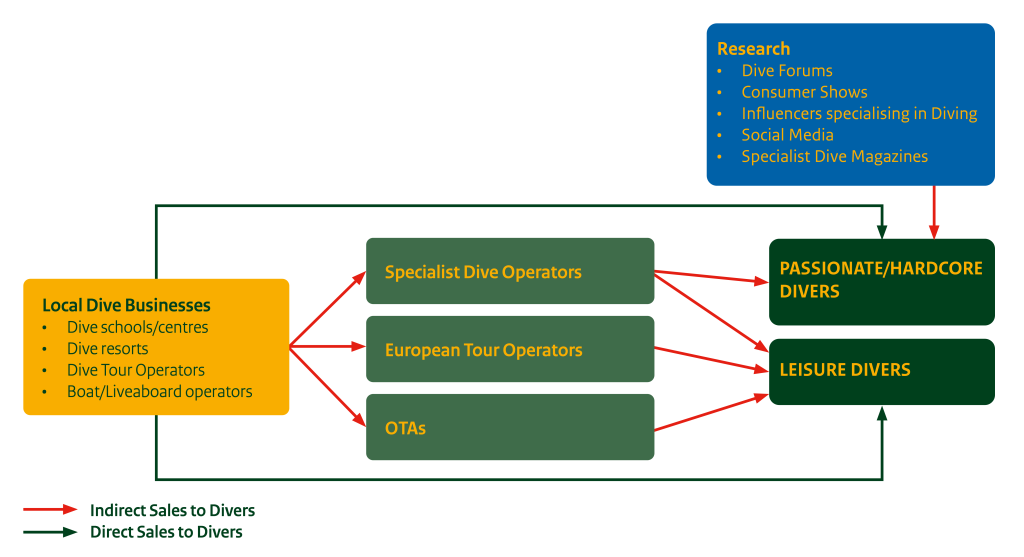
Source: Acorn Tourism Consulting, 2024
Here is an explanation of the different channels:
- Specialist dive operators: There are many specialist dive companies on the European market. They are very knowledgeable about the dive market and know their customers well. They have built strong relationships with their local suppliers to provide the experience required. Companies in the different source markets include Dive Worldwide and Regaldive (UK), Viaggi per Sub and Profondo Blu Viaggi Sub (Italy), Absolut Scuba and SUB AQUA Tauchreisen (Germany), Ultramarina (France), Buceo Safari and BuceoyViajes (Spain), and Najlepsze Nurkowania (Poland).
- European tour operators: General tour operators often include diving as a themed holiday in their portfolios. They are more likely to be used by leisure divers. Some operators are Weg and Urlaubspiraten (Germany), Sunweb (France), TUI (France and Germany), Hayes & Jarvis and Lastminute.com (UK).
- Online travel agencies (OTAs): Travellers who want to try diving, or do one or two dives while on a trip, may use an OTA to book. OTAs include Viator, GetYourGuide and Musement.
- Direct sales: Booking directly with a dive school or centre, local dive tour operators, and/or boat or liveaboard providers is an important sales channel for all types of divers, from beginners to advanced. Often, divers book once they have arrived at their destination.
What is the most interesting channel for you?
Direct sales and European tour operators are both important sales channels if you have a dive tourism business.
To reach the European market directly you should have an online presence, through your website and social media channels. Divers do lots of research before they travel to help them find out the best places to dive, and if you do not have an online presence they will not find you. To help you improve your online presence, consult the CBI study How to be a successful tourism company online?
Tips:
- Do an internet search to identify specialist dive tour operators in the source market countries. Take time to explore the websites so you can get a good picture of what they offer and the sort of divers that use their services. Find out whether they work in your destination.
- Research your competitors in your area and/or region. Find out where they are based and what they offer. See what you could offer that is different or adds value.
- For more tips on doing business with European tour operators, download the CBI study 10 tips for doing business with European tourism buyers.
3. What competition do you face on the European dive tourism market?
Which countries are you competing with?
Many of the best destinations for diving are in developing countries. They have some of the best diving conditions in clear water and spectacular underwater environments. The top countries are Indonesia, Egypt, Mexico and Ecuador.
But there are many more competing destinations, like Belize, Jordan, the Philippines, Tobago, Palau, the Maldives, Thailand, Fiji, and other islands in the South Pacific, especially known for ship and aircraft wrecks.
Egypt
Egypt is located on the Red Sea, one of the best places to dive in the world. The Red Sea is very accessible to Europe, making it an extremely popular dive destination for the major source markets. It is one of the most important hubs of marine biodiversity and has a rich underwater ecosystem. It is home to 300 species of coral and 1,200 species of fish. Popular dive sites include the Shark and Yolanda Reef in Ras Mohamed National Park, the Elphinstone Reef at Marsa Alam, Jackson Reef in the Straits of Tiran at Sharm El Sheikh, and the SS Thistlegorm wreck at Sha’ab Ali.
Egypt has the world’s largest reef economy, generating about US$7 billion a year from diving and snorkelling activities. As the dive industry developed in the 2000s, the government established the Egyptian Chamber of Diving and Water Sports (CDWS) to oversee diving standards. The CDWS adopted the ISO24803:2017 as the required standard for all dive businesses.
Egypt is working to promote sustainability in tourism. ECO EGYPT was launched in 2020 by the Ministry of Environment (MoE) and Mainstreaming Biodiversity in Egypt’s Tourism Project (MBET). It is a nationwide campaign that aims to enhance sustainable tourism, and is a series of activities that encourage sustainable and responsible tourism for travellers seeking unique experiences, including diving. ECO EGYPT has also collaborated with Green Fins.
Mexico
Mexico offers year-round diving opportunities, with excellent diving sites in the Caribbean Sea and the Pacific Ocean. In Yucatan, diving in the freshwater cenotes (underwater caves) is popular. Dive sites by the small island of Cozumel, off the Yucatán Peninsula, are popular worldwide. Cabo Pulmo National Marine Park is a successful marine reserve created at the southern tip of Baja California. Ten years after designation, fish biomass had increased by 463%. It was named a UNESCO World Heritage Site in 2005.
A study from 2021 found that dive tourism is worth as much as fishing, and that divers and snorkellers generate between US$455 million and US$725 million every year. The study identified 264 diving businesses and over 860 dive sites. Most sites are visited by small dive businesses, which make up 97% of Mexico’s diving industry. It is hoped that collaboration between the two industries will support sustainable growth, providing greater returns for both tourism and fishing while reducing pressure on the marine biodiversity.
Indonesia
Indonesia is one of the best diving destinations in the world. There are more than 17,500 islands and many options for divers of varying abilities. Raja Ampat is believed by some to be the best spot in the world, with spectacular coral reefs. There is drift diving in Komodo and diving with pelagic species in Lombok. The Coral Triangle, an area of 6 million square km, has huge biodiversity and many thousands of marine species. Wreck diving is renowned off West Papua, where there are several easily accessible wrecks.
Figure 4: Face to face – diving in an artificial reef in Bali
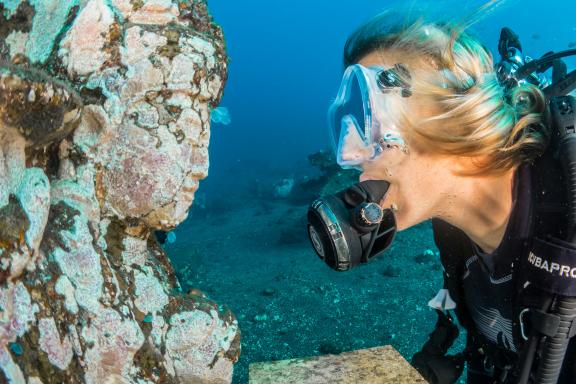
Source: Sebastian Pena Lambarri at Unsplash, 2018
The dive industry is well established in Indonesia and there are many dive resorts and liveaboard operators. The tourism industry is experiencing growth, driven in part by global recognition of diving opportunities along with a wide range of cultural attractions and stunning natural landscapes. It is estimated to be worth US$1.991 billion every year. There is a growing awareness of the need for sustainable tourism practices in diving, and many dive operators are Green Fins members and/or PADI 5-star eco-resorts.
But challenges remain, as there are areas under threat from coral bleaching, marine pollution and unsustainable tourism practices. These issues could have a major impact on the ecosystems the diving industry relies upon. There is a need for stakeholders to implement regulation and safety standards to mitigate against these impacts. Still, the outlook for diving in Indonesia remains positive if collaboration between stakeholders creates a balanced future.
Ecuador
The Galápagos Islands in Ecuador are well-known for their high levels of biodiversity, both on land and underwater. Encounters with large and rare marine life, such as over 30 species of shark, the very rare marine iguana, manta rays, and turtles are common when diving. Liveaboard vessels offer the opportunity to cover most of the best dive sites in one visit.
With a year-round diving season, around 18,000 visitors dive annually during their visit to the Islands. Compared to land-based tourists, who stay for an average of 5-7 days, divers stay longer, for an average of 10 days.
DiveStat is an official programme established in 2012 to collect data on the impacts of diving at sites around the Galápagos Islands. DiveStat aims to help boost the ocean economy sustainably, ensuring that tourism and local livelihoods grow while minimising the impact on the ecosystem. Volunteers dive with groups of divers to record diving behaviour, for instance how often a reef sustains diver damage. With this information they tailor their diver briefings.
Figure 5: Data collected by DiveStat on diver-related damage in the Galápagos Islands
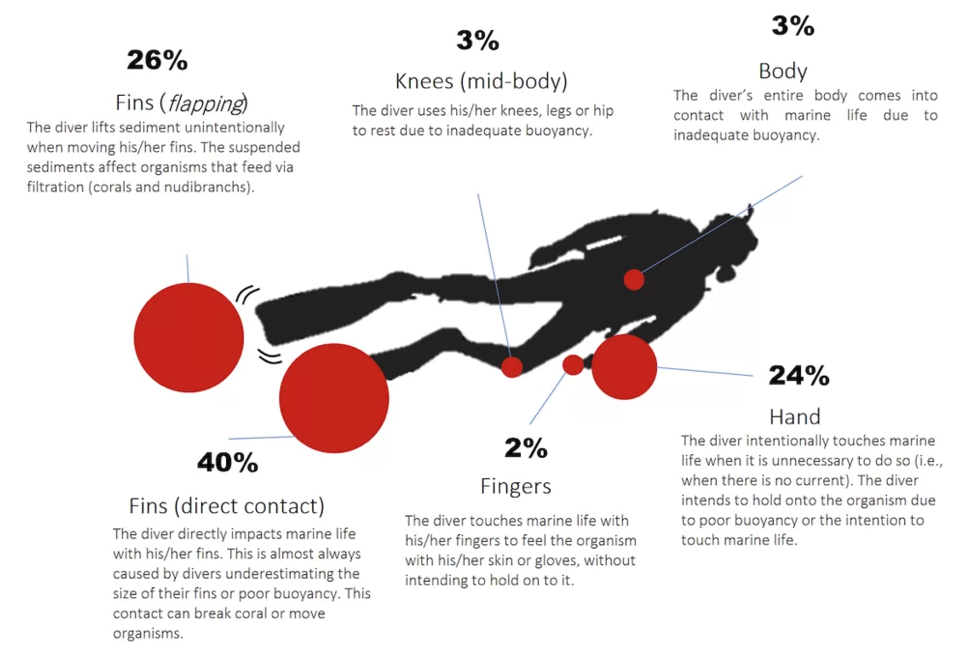
Source: DiveStat project; Galápagos Report, date unknown
Key takeaways:
- You should be completely knowledgeable about the dive product in your destination. Make sure you know where the dive sites are and what divers will see – coral reefs, wrecks, marine life and any spectacle like feeding or breeding. You should also be fully aware of any seasonal issues. These are all factors that European divers will want to know before they dive with you.
- Sustainable diving is a must for European divers. You must operate your business sustainably and make sure you tell your customers what you do. Guiding divers’ behaviour underwater is a crucial task so they know not to touch or get too close to any animals. Use Green Fins’ comprehensive guidance to help you.
Which companies are you competing with?
Dive businesses are very common in all competing destinations. They range from dive centres and schools to dive resorts, dive tour operators and dive rental shops.
Egypt
Marsa Nakari near Marsa Alam, 3.5 hours north of Hurgada, is a PADI Eco Dive Centre that has put the environment at the heart of its business. It is one of three villages managed by Red Sea Diving Safari, a leading environmental organisation and pioneer of sustainable tourism development. Divers, snorkellers and free divers can access the house reef directly from the shore. Further out, the world-renowned marine protectorate of Shaab Samadai is home to spinner dolphins. The website has full details on all the dive sites that can be reached from the village.
Visitor capacity is managed in the small village based on what they believe the reef can take without causing a negative impact. The village chose to implement solar power systems to reduce its carbon footprint at a time when fossil fuels were heavily subsidised. It operates conservation programmes to help divers contribute to the health of the underwater world while enjoying it at the same time. Divers Against Debris is a certification course that is offered for free to all divers.
Scuba Seekers is based in Dahab and offers diver training, guided dives and diving safari trips. Divers can also book liveaboard trips on the MVLegends II vessel. They cater to divers of all abilities. It is a PADI 5-star instructor development centre and a member of Green Fins. They manage a range of conservation initiatives, including conservation courses. These include fish surveying programmes and reef ecology dives, both for advanced divers. They also organise clean-up dives every Monday, and ghost dives to remove lost (ghost) fishing gear from the water.
Mexico
Dive Ninja offers a range of experiences including diving, free diving, whale watching and diving courses. Sustainability and conservation are at the heart of its business. They do not have any single-use plastics in their shop or on their trips, and actively support marine conservation and research projects locally and internationally. Based in Cabo San Lucas, in the Baja California region on the Pacific coast, it became the first PADI Eco Center in Mexico in May 2023 and is a member of Green Fins.
Its website is inspirational and full of exciting images. It is easy to navigate and makes the user want to find out more. It features the organisations it is associated with, and the logos link through to each website or relevant page. There are plenty of links to internal pages and external sites, which is good website practice.
Yucatan Dive Crew specialises in trips to dive cenotes, underwater caverns that are especially prominent in the northern region of the Yucatan Peninsula. Cenotes can only be dived by certified divers, and the company offers the PADI Cavern Diver Course. The business is owned and managed by diving professionals who have a combined expertise of more than 25 years.
The operator has a blog page with some useful features like the top 7 cenotes for diving in Mérida and 5 things to know before diving in Mexico. These types of blogs are good for SEO (search engine optimisation), which will help your business to be found, as people like to read tip-based blogs when researching their trips.
Indonesia
Ceningan Divers in Bali is a PADI 5-star dive resort, a PADI Eco Dive resort and a top 10 global Green Fins gold member. The operator was founded on three core values: that marine conservation is a priority, diving education should be safe and fun, and team and guests are the lifeblood of the business. This clearly stated USP (unique selling point) is appealing to European divers. The resort is also CHSE-certified (Clean Health Safety Environment). CHSE is an Indonesian tourism scheme specially developed as a response to the Covid-19 pandemic.
The website features several icons that link to associated businesses, including Green Fins, Tripadvisor, and the Marine Megafauna Foundation, which is excellent website practice and a very easy thing to do. There are lots of blogs and articles, and a section specifically about their conservation activities. They undertake numerous activities like recording and sharing data, no use of single use plastics, and island-cleaning initiatives.
Two Fish Divers has two centres in Bali and Manado. It is a PADI 5-star dive centre and offers services such as guided dives, diving courses, and Divemaster and Instructor internships. Divers can book multi-location dives, and the operator manages all the transfers. They also operate a loyalty scheme where divers can earn free dives. They feature links to customer testimonials high up on the homepage (Google and Tripadvisor), though it would be better if the icons linked through to the actual pages.
The operator also features good reasons to choose them for a diving experience, which helps set them apart from competing operators. If you offer a service that is different from your competitors, be sure to feature it clearly on your website. The website is attractive and informative, but there is not enough information about their sustainability actions.
Figure 6: Reasons to choose Two Fish Divers
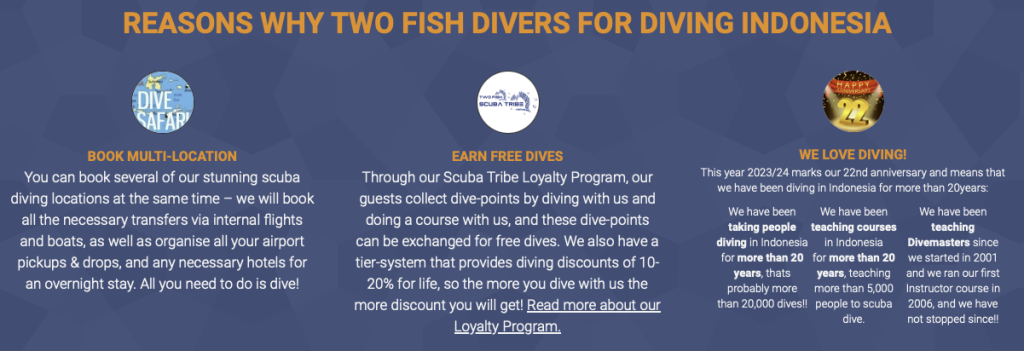
Source: Two Fish Divers, 2024
Ecuador
Scuba Iguana offers a range of packages, courses and cruises, plus manages a guest house. It also offers an opportunity for qualified divers (PADI Open Water or equivalent) to do an unpaid six-week internship with the team, helping to manage the business. In return, participants receive a diving course and two extra dives every week. It is a PADI 5-star dive resort and is sustainably certified with TourCert.
The operator collaborates with Galápagos scientists and park rangers to monitor marine species in the Galápagos Marine Reserve, the Shark Count Galapagos. Guests are encouraged to support the initiative through the app and note the number of animals seen on each dive.
Aqua Ventures Galápagos is an adventure dive centre and eco-tour agency. With 10 years of experience, it has conducted 854 dives and 1,248 tours. It offers a range of tours in and around the three main islands of San Cristobal, Santa Cruz and Isabela. Guides are certified by the National Park Galápagos, and instructors are PADI-certified. Safety and good value are two important factors that it highlights on its homepage using a compelling infographic. They also provide some equipment for rent, including cameras and dive computers.
Figure 7: Use compelling infographics to highlight your key messages
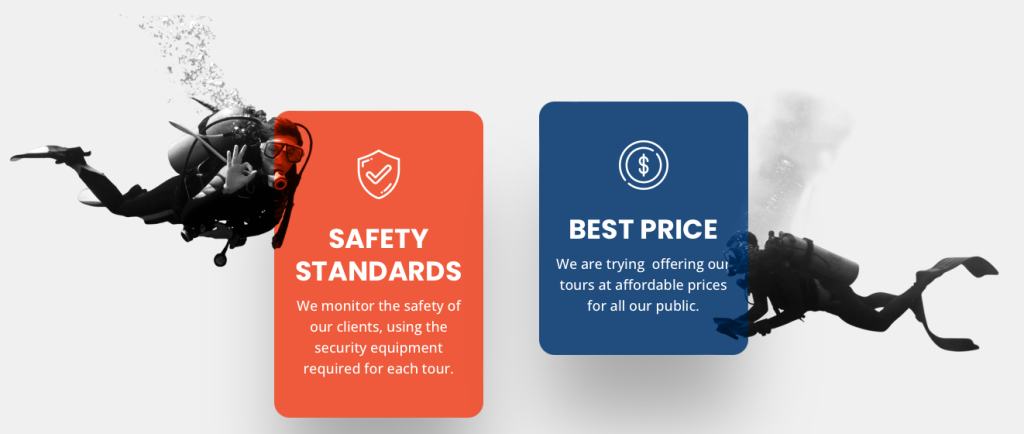
Source: Aqua Ventures, 2024
The website is nicely and attractively designed, with large, inspirational images and an intuitive scrolling homepage. Calls to action buttons are bold and obvious, and the moving features, like the moving numbers, attract the user’s attention. All these features are good to keep users interested in your website and what you have to offer.
Key takeaways:
- Make your website inspirational. Use lots of images/videos of divers and the underwater environment to inspire potential divers. To highlight your strengths, use infographics like the one shown above. Download the CBI guide How to be a successful tourism business online?[TC-VU2] , to help you develop or update your website.
- On your About Us or Team pages, highlight your diving credentials to reassure potential divers.
- Include links to any organisations you are associated with, like PADI, Green Fins or Tripadvisor. This is important, as being associated with organisations like these will enhance your reputation.
- Make sure to market your sustainability actions on your website. Consider what new actions you could introduce, like a beach clean-up. Or find out from local conservation groups whether there are other initiatives you could take part in.
- Have a blog page where you can include features about diving in your destination and other interesting facts. Make sure you post regularly, at least once or twice a month. Tip-based blogs are popular.
- Include customer testimonials or links to such testimonials on your Tripadvisor or Google page(s). If you get negative feedback, be sure to respond to it and act on the information.
Which products are you competing with?
Dive tourism is very specific, so your major competitors are businesses offering similar services to you. Undertake a competitor analysis to identify competing businesses. Assess how their offer differs from yours. Once you have done this, you will be able to spot any gaps in the market. Can you take divers to different sites, or offer a package that is different from theirs?
4. What are the prices of diving travel products on the European market?
Generally, diving is an expensive activity. There are high costs involved with purchasing equipment, filling tanks, operating boats and paying skilled instructors to teach and/or guide. Some destinations are pricier than others and it can also be more expensive to reach them. The Galápagos Islands and Palau are two of the most expensive destinations. By contrast, Egypt, Thailand and Mexico are more budget-friendly options.
Dive tourism prices can be complex. The prices published by operators are frequently broken down by:
- Package price – this may or may not include the boat hire.
- Rental costs – the cost to hire scuba gear, fins, mask and snorkel, tanks, etc.
- Boat hire – if it is not included in the package price.
- Food and drink – particularly for a day trip on a boat.
- Marine reserve fees or other – if applicable.
- Insurance – if applicable.
When setting your prices, be clear about what is and is not included in your pricing.
Read this PADI blog, which helps divers on a budget to find cheaper deals. Note that PADI encourages them to check testimonials and reviews to ensure they are choosing a reliable and safe option.
Table 2: Some dive courses and packages on the European market, May 2024
| Dive Experience | Location | Duration | Price per person from € |
| Open Water Diver (PADI) | |||
| 5 dives | Indonesia | 2-3 days | 369 |
| Egypt | 385 | ||
| Mexico | 483 | ||
| Galápagos | 674 | ||
| Dive Experiences | |||
| Mobula Ray free diving and snorkelling tour | Mexico | Half day | 88 |
| 2 Dive Package to Ras Abu Gallum | Egypt | 1 day | 115 |
| 2 tanks local diving in Cabo Marine Park | Mexico | Half day | 120 |
| Night diving | Galápagos | 2.5 hours | 131 |
| 3 Dive Crazy Shark Day, Komodo | Indonesia | 1 day | 144 |
| Snorkelling at North Seymour | Galapagos | 1 day | 148 |
| 6 Dive Package in Sharm El Sheik | Egypt | 3 days | 155 |
| Cenote tour | Mexico | 1 day | 221 |
| 2 tanks Gordo Banks trip | Mexico | 1 day | 231 |
| 6 Dive Package in Komodo | Indonesia | 2 days | 274 |
| Weekender Dive Package, 2 dives | Indonesia | 2 days | 334 |
| Dive & Stay Package, 9 dives | Indonesia | 3 days | 495 |
| Diving Package in San Cristobal | Galápagos | 3 days | 503 |
| Scuba and stay | Egypt | 5 days | 520 |
| Galápagos Adventure package | Galápagos | 7 days | 1,025 |
| VIP Liveaboard . 15 dives | Egypt | 6 days | 1,195 |
Source: Acorn Tourism Consulting, 2024
Acorn Tourism Consulting Limited carried out this study on behalf of CBI.
Please review our market information disclaimer.
Search
Enter search terms to find market research
